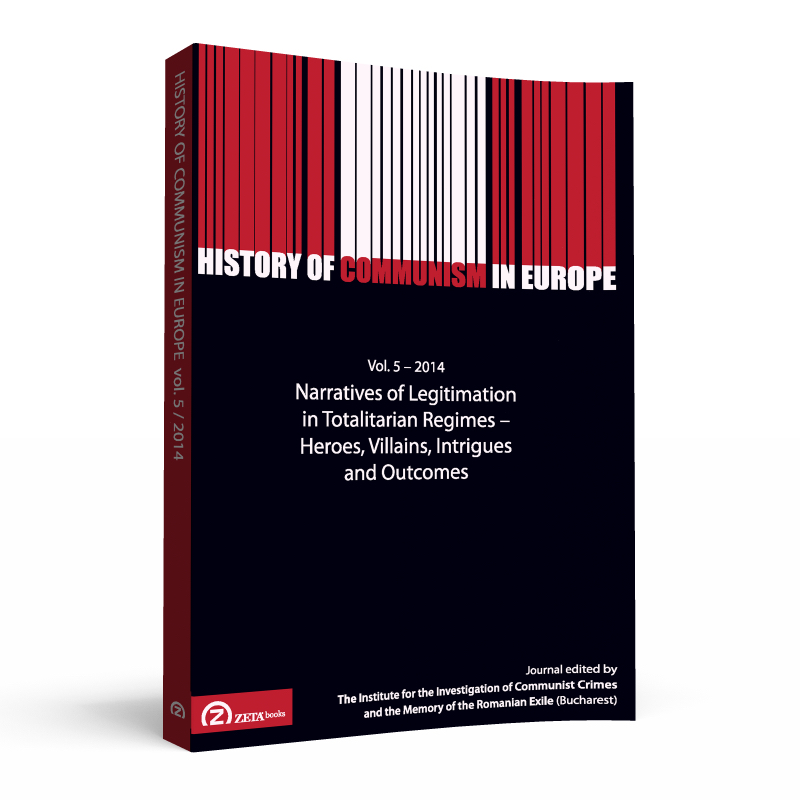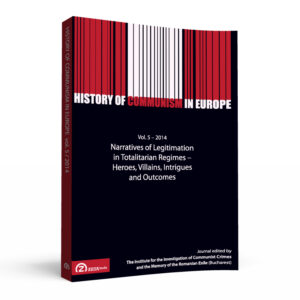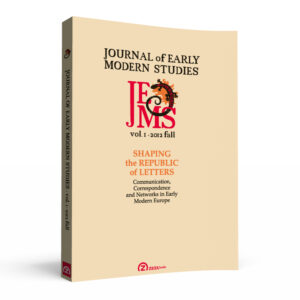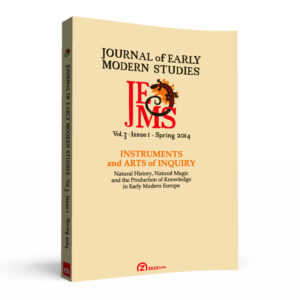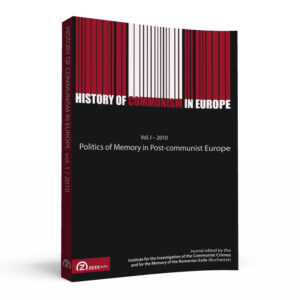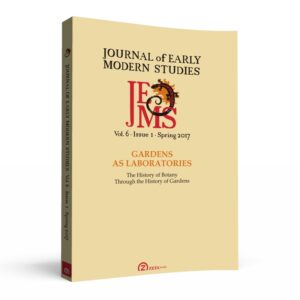TABLE OF CONTENTS
Dalia BÁTHORY: Weaving the Narrative Strings of the Communist Regimes – Building Society with Bricks of Stories
- Abstract: The long duration of the Communist regime cannot be explained without closely looking at the manners of creating shared meanings and agreement on explanations on the shared historical context. Narratives of legitimation, some easier to depict than others, were almost as important as the use of force in imposing the specifi c values of the regime. In other words, soft power was the buttress of hard power. But the nuances are numerous, once we put this otherwise obvious remark under closer scrutiny. The case studies presented in this issue of the yearbook underline the practice of combining soft power with hard power: that is, legitimating narrative discourses transmitting sets of values and beliefs, backed up by policies of various forms of violence.
I. HEROES AND VILLAINS – DEVELOPING THE CHARACTERS
Ștefan BOSOMITU: Becoming in the Age of Proletariat. The Identity Dilemmas of a Communist Intellectual throughout Autobiographical Texts. Case Study: Tudor Bugnariu
- Abstract: Romanian historiography generally states that in Communist Romania there was no intellectual capable of stimulating a “heresy” comparable to those in Yugoslavia (Milovan Djilas), Hungary (György Lukács) or Poland (Adam Schaff ). This is almost true. While the Romanian Communist/Workers Party (RCP/RWP) despised intellectuals, even if they were docile and obedient, in the upper echelons of the RCP/RWP one could hardly fi nd true intellectuals. However, there were some cases that can challenge this narrative – Lucreţiu Pătrăşcanu, Grigore Preoteasa, Miron Constantinescu or Tudor Bugnariu. My paper will discuss the case of Tudor Bugnariu, one of the intellectuals seduced by the communist project and ideology in interwar Romania, who later managed to occupy important offices within the RCP/RWP and the state structures. By analyzing the narratives of Tudor Bugnariu’s several autobiographical texts, my paper will examine and explain his becoming and the construction of his self-identity and of his “revolutionary” self.
Renata KIRIN: Yugoslav Women Intellectuals: From a Party Cell to a Prison Cell
- Abstract: The Yugoslav socialist framework enabled major advances in what concerns the legal, economic and social equality of women, advances which radically changed their traditionally subordinated family and social position. In spite of the postwar period of revolutionary enthusiasm, female political activism and the access of women intellectuals to the male-dominated spheres of journalism, diplomacy, administration and governmental offi ces did not exist for long. Taking into account memoirs and oral histories of fi ve distinguished women, the article reveals the reasons for the Party’s antifeminist attitudes: a) the political fear of ambitious female “quality staff ”; b) the ideological fear of the women guardians of the traditional and religious foundations of collective identity; c) a cultural mistrust toward the mobile woman who easily transcends family, social and ethnic boundaries. These biographical sources reveal that any attempt at free thought and autonomous action outside of the party line was severely punished.
II. NARRATIVES OF LEGITIMATION – FROM REALITY TO FICTION THROUGH ARTS
Barbara LOACH: Topographies of Identity and Memory: Berlin’s “Ghosts” and “Book of Clouds” by Chloe Aridjis
- Abstract: The focus of this study is the city of Berlin as a site of contested spaces and its representations in the novel Book of Clouds (2009) by Chloe Aridjis. As a number of recent books on Berlin have indicated, the ongoing efforts to physically re-configure historical sites in the city and construct a new post-unification identity for the capital and the nation has produced dissonance between long-standing national narratives of identity and the challenges presented by new identity narratives. The foundation of cultural identity, social memory, is political, shaped and wielded by those in power. Yet, as Michel de Certeau has posited, such power can be contested at the street level where ruptures can be observed. Book of Clouds, the first novel by transnational author Chloe Aridjis, explores the relationship of identity and memory as Tatiana, a young Mexican Jewish woman living in Berlin in the first decade of the twenty-fi rst century, observes and interacts with the city and its inhabitants from an outsider’s perspective.
Sebastian HALLER: “Diesem Film liegen Tatsachen zugrunde …”. The Narrative of Antifascism and its Appropriation in the East German Espionage Series Das unsichtbare Visier (1973-1979)
- Abstract: Since narratives of legitimation have to adapt to shifting discursive environments, they cannot be regarded as static phenomena. To present a sound understanding of their embedment in a specific context, narratives have to be approached from a variety of perspectives – they necessitate, in other words, a “thick description”. This paper addresses the narrative of antifascism as a central element of public discourse throughout the history of the German Democratic Republic (GDR) and contextualizes it specifically in East German television culture. In addition to providing an understanding of antifascism as an ideological signifier exclusively for historical phenomena, such as National Socialism (NS) or Italian fascism, this paper proposes to conceptualize the narrative of antifascism – as it was officially defined in the GDR/SBZ – as a discursive formation that encompasses various political narratives such as militarism and imperialism, as well as past and present political events. Based on this assumption, the highly successful espionage series Das unsichtbare Visier (1973-1979), which was produced by the DEFA and broadcasted by the East German state television (DFF/DDR-F), will be discussed in relation to its exploitation of the narrative of antifascism. By approaching these issues, it is the objective of this paper to examine the practices of the appropriation of the narrative of antifascism in an era that was marked by the development of popular (socialist) television culture and, moreover, to contribute to the discussion of the dialectic between stability and flexibility that is inherent to narratives.
III. WEAVING THE NARRATIVE THREADS – INTRIGUING STRATEGIES, PUZZLING OUTCOMES
Radu STANCU: The Political Use of Capital Punishment as a Legitimation Strategy of the Communist Regime in Romania, 1944-1958
- Abstract: In this article, I will describe the evolution of capital punishment and the infl uence that ideology had during the founding years of Romania’s communist regime, until 1958, when the legislation and application of capital punishment reached its highest peak. Starting with the punishment of war criminals and fascists, I will then describe how the death penalty was used for political motives in a period when the regime had to consolidate, legitimate and fight different enemies. With ups and downs like The Death Penalty Law of 1949 and the abolitionist attempt in 1956, it reached its climax in 1958-1959 after the enactment of Decree no. 318/1958.
Giuseppe PERRI: Korenizacija as an Ambiguous and Temporary Strategy of Legitimation of the Soviet Power in Ukraine (1923-1933) and its Legacy
- Abstract: The Soviet government showed evidence of poor linearity in its policies towards nationalities. Not only does this policy appear to have been contradictory in several places, but has undergone changes and transformations over the years, so as to make it almost unreadable. Meanwhile, in order to attract the nationalities that were part of the Russian Empire and in accordance with the principle enunciated by Lenin, namely that the Empire was a “prison of peoples”, in the first decade of Soviet power an ambiguous policy of enhancement of nationalities was passed that received the name of indigenization or korenizacija; ambiguous, because the aim was also to categorize and control the population, according to a typical perspective of colonial power.
Ioana URSU: Narrativity and Legitimation in the Discourse of the Communist Archives: Analysing the Files of „the Burning Bush Organization”.
- Abstract: Our paper proposes to follow the history of the “Burning Bush”, a spiritual and cultural movement in the 1940s in Romania that had proposed the solution of spiritual resistance to communism through culture and faith. The analysis holds as key-concepts: discourse analysis, narrativity, semantics and hermeneutics, following the discourse of the Securitate’s archives with reference to the Burning Bush in terms of: – conflictual discourses: inquisitor vs. imprisoned; – motives and themes of the incriminatory discourse of the Securitate; – the existence of a master narrative of the archives.
Andrea TALABÉR: Medieval Saints and Martyrs as Communist Villains and Heroes: National Days in Czechoslovakia and Hungary during Communism.
- Abstract: This paper examines the transformation of medieval figures from state “heroes” during the interwar years into “villains” of the Communist state in Czechoslovakia (St Wenceslas and Jan Hus) and Hungary (St Stephen) through their national day commemorations. I argue that the negative treatment of these medieval heroes was not clear-cut and, especially in Hungary, they enjoyed a comeback of sorts during the second half of the Communist era. This article thus demonstrates, through official commemorative events, that the Communist regimes of Czechoslovakia and Hungary to some extent were ready to continue with national symbols and traditions that were firmly established in the previous era and had apparently been abolished by the Communist regimes themselves.
Camelia LELESAN: The Power of the Ritual – the System of Rites as a Form of Legitimacy in the Soviet Union
- Abstract: The end of the Second World War produced a shift in the Soviet mode of legitimation; the original values of Marxism-Leninism were combined with those of patriotic nationalism in a new form of ideology in which the idea of The Great Patriotic War became one of the founding myths. Especially after Stalin’s death in 1953 and the beginning of the process of de- Stalinization, the Soviet political elites made an attempt to change their strategy by reducing reliance on coercion and strengthening political legitimacy in order to gain compliance from the ruled population. The system of socialist ritual became one of the most important legitimation procedures. The political elites came to regard the system of ritual as an important factor in maintaining and strengthening the legitimacy of the regime and their own positionin the power structure.
Nikola BAKOVIĆ: From Mother’s Day to “Grandma” Frost. Popularisation of New Year Celebrations as an Ideological Tool. Example of Čačak Municipality (Serbia) 1945-1950
- Abstract: This micro-historical case-study of the role of the Antifascist Front of Women of Yugoslavia in popularising New Year celebrations in the Serbian municipality of Čačak aims to examine the internalisation of the communist discourse through ritual practices serving to infiltrate the private life of the local community and to expand the Party’s support basis. In the first post-war years, the new authorities not only tolerated, but tacitly approved and aided celebrations of Christian holidays. Yet this policy changed radically in 1948, when local mass organisations were instructed to replace winter holidays with New Year festivities, based on the Soviet model. These events bore an observably ideologised character, since New Year’s Day was not only supposed to mark the calendar year’s end, but also to symbolise the new beginning as a ubiquitous simulacrum for a new socialist society. The primary agents of this novel collective identity practice were women, champions of the socialist emancipation project, whereas the main channel for dissemination were children, which embedded this measure within the farsighted project of tempering a “new man.”
IV. BOOK REVIEW
Bruno KAMINSKI: Marcin ZAREMBA, Wielka Trwoga. Polska 1944-1947. Ludowa reakcja na kryzys, [The Great fear. A popular reaction to crisis], Znak, Warsaw, 2012.
ISSN: 2069-3192 (paperback)
ISSN: 2069-3206 (electronic)
ISBN: 978-606-8266-96-1 (paperback)
ISBN: 978-606-8266-97-8 (e-book)

